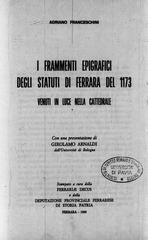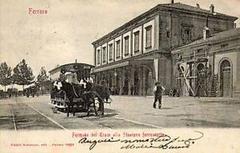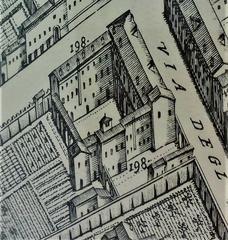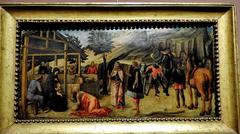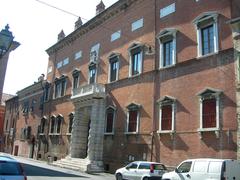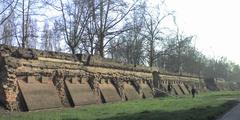
Palazzina Marfisa d’Este: Visiting Hours, Tickets, and Ferrara Historical Sites Guide
Date: 04/07/2025
Introduction
Nestled just outside the medieval walls of Ferrara, the Palazzina Marfisa d’Este is one of the city’s most captivating Renaissance residences. Built around 1559 by Francesco d’Este, son of Duke Alfonso I d’Este and Lucrezia Borgia, this villa was conceived as a “delizia”—a luxurious estate dedicated to leisure, culture, and artistic enjoyment. Named for Marfisa d’Este, a prominent patron and court figure, the palazzina offers visitors a vivid window into the sophistication of Renaissance Ferrara, once celebrated as a center of artistic and political innovation (Musei Ferrara; Antica Ferrara).
This guide provides comprehensive information for visitors: from historical context and architectural highlights to practical details such as visiting hours, tickets, accessibility, and tips for exploring nearby attractions. With extensive restorations completed in 2025, Palazzina Marfisa d’Este now welcomes a new generation of guests eager to immerse themselves in Ferrara’s Renaissance heritage (La Nuova Ferrara; Zazoom).
Contents
- Introduction
- Historical Origins and Construction
- Architectural Significance
- Marfisa d’Este and the Este Legacy
- Artistic Features and Museum Experience
- Visiting Information
- Hours & Tickets
- Accessibility
- Getting There & Travel Tips
- Nearby Attractions
- Guided Tours, Events, and Educational Role
- Restoration and Modern Museography
- Visitor Amenities
- Frequently Asked Questions (FAQ)
- Conclusion & Call to Action
- Sources
Historical Origins and Construction
Commissioned by Francesco d’Este in 1559, the Palazzina Marfisa d’Este was designed as a summer retreat and a symbol of the Este family’s refinement. Set just beyond Ferrara’s medieval walls, it was surrounded by gardens and orchards, providing a tranquil escape for the court. Its architectural plan—a central hall flanked by side rooms—reflects Renaissance ideals of harmony and privacy, while the villa’s location underscores the Este tradition of integrating art, leisure, and nature (Musei Ferrara).
Architectural Significance
The palazzina exemplifies late Renaissance residential design with its harmonious proportions, brick façade, and monumental marble portal. A single-story structure, it emphasizes horizontal lines and openness, contrasting with medieval verticality. The loggia and garden, historically used for performances and gatherings, reflect the Renaissance ideal of blending indoor and outdoor spaces for leisure and contemplation (Wikipedia; Nomads Travel Guide; Ferrara Terra e Acqua).
Marfisa d’Este and the Este Legacy
Marfisa d’Este (1554–1608), daughter of Francesco d’Este, was the principal resident and namesake. Renowned for her patronage and strong personality, she played a vital role in Ferrara’s cultural life—hosting artists and literary figures, including Torquato Tasso (Antica Ferrara; ViViGreen). The Este dynasty’s court was one of Italy’s most vibrant, fostering artistic and intellectual innovation that still echoes in Ferrara’s cultural landscape.
Artistic Features and Museum Experience
Frescoes and Decoration
The interiors are adorned with refined frescoes attributed to the workshop of Sebastiano Filippi (Il Bastianino), featuring mythological and allegorical themes rendered in the “grottesche” style. These decorations embody the Renaissance fascination with classical antiquity and illusionistic art (Musei Ferrara; Antica Ferrara).
Loggia and Grotta
A tripartite loggia opens onto the garden, creating a seamless flow between interior and exterior. The adjacent “Grotta,” a garden pavilion with painted landscapes, offered a cool retreat and a space for select gatherings, echoing the Este tradition of blending art, nature, and social ritual (Museo Ferrara).
Period Furnishings
While some original furnishings were lost, the museum’s 20th-century restoration has recreated the noble ambiance with period-appropriate pieces, including 17th-century credenzas in the Sala Grande. Visitors experience the spatial richness and decorative elegance characteristic of the Este court (ViViGreen).
Notable Artworks
The Loggetta dei Ritratti features a portrait of Marfisa as a girl, attributed to Camillo Filippi, providing a personal connection to the villa’s history (Cambridge University Press).
Visiting Information
Hours & Tickets
- Opening Hours: Tuesday to Sunday, 10:00 AM – 6:00 PM. Closed Mondays and selected holidays. Please check the official website for any seasonal variations or special event schedules.
- Tickets: Standard adult admission is €8; reduced rates are available for EU citizens aged 18–25 (€5). Free entry for children under 18 and Ferrara residents. Tickets can be purchased online or at the entrance. Advance booking is recommended during peak periods (Artsupp; Comune di Ferrara).
Accessibility
Recent restorations have greatly improved accessibility. There are ramps and adapted restrooms on the ground floor, and staff assistance is available upon request. Some upper rooms may remain inaccessible due to architectural constraints; visitors with specific needs should contact the museum in advance (Artsupp; Visit Ferrara).
Getting There & Travel Tips
- Location: Corso della Giovecca, 170, Ferrara, Emilia-Romagna, Italy.
- Transport: Easily reached by foot, bicycle, or local buses (lines 6 and 7). Limited parking is available nearby, but walking or cycling is recommended.
- Best Times to Visit: Weekday mornings and late afternoons for a quieter experience. Spring and autumn are ideal for enjoying the gardens (Artsupp).
Nearby Attractions
- Schifanoia Palace: Five-minute walk from the palazzina.
- Este Castle: The iconic moated castle of Ferrara.
- Ferrara Cathedral: A blend of Romanesque and Gothic styles.
- Palazzo dei Diamanti: Renowned for its unique façade and art exhibitions.
- Jewish Ghetto and City Walls: Explore Ferrara’s historical neighborhoods and defenses (Hikersbay).
Guided Tours, Events, and Educational Role
Guided tours are available in Italian and, on request, in English or other languages. These tours provide in-depth historical and artistic context. The museum also hosts special exhibitions, concerts, and cultural events, particularly during local festivals. Educational materials and interpretive panels are provided to enhance the visitor experience (ViViGreen; Antica Ferrara).
Restoration and Modern Museography
After the 2012 earthquake, the palazzina underwent major restoration, completed in 2025. These efforts focused on structural reinforcement, fresco conservation, and improved accessibility. Modern museographic techniques—such as digital displays and interactive guides—now complement the historical narrative (La Nuova Ferrara; Zazoom).
Visitor Amenities
- Restrooms and Cloakroom: Available on the ground floor.
- Gift Shop: Sells books, souvenirs, and materials related to the Este family and Ferrara’s Renaissance.
- Photography: Non-flash personal photography is permitted, except in restricted areas.
Frequently Asked Questions (FAQ)
Q: What are Palazzina Marfisa d’Este’s opening hours?
A: Tuesday to Sunday, 10:00 AM–6:00 PM. Closed Mondays.
Q: How do I buy tickets?
A: Purchase online via the official website or at the entrance.
Q: Is the palazzina accessible to those with disabilities?
A: The ground floor is fully accessible; some upper areas may require stairs.
Q: Are guided tours available?
A: Yes, in Italian and other languages on request.
Q: Can I take photographs?
A: Non-flash photography is generally allowed except where otherwise indicated.
Conclusion & Call to Action
Palazzina Marfisa d’Este is a jewel of Ferrara’s Renaissance heritage, offering a uniquely immersive experience of noble life, art, and architecture. With recent restorations ensuring accessibility and preservation, every visitor can appreciate the villa’s elegance and historical significance.
Plan your visit by consulting the latest information on opening hours and ticketing. For an enhanced experience, download the Audiala app for audio guides and virtual content. Combine your tour with stops at nearby Este landmarks to explore Ferrara’s full UNESCO-listed cultural itinerary.
Stay connected for updates and events via official museum websites and social media. Begin your journey into the heart of Renaissance Ferrara today.
Sources
- Musei Ferrara – Palazzina Marfisa d’Este
- Musei Ferrara – Palazzina Marfisa d’Este
- Antica Ferrara – Palazzina Marfisa d’Este
- Artsupp – Palazzina Marfisa d’Este
- La Nuova Ferrara – Riapre la Palazzina Marfisa d’Este
- Zazoom – Palazzina Marfisa d’Este e Accessibilità
- Cambridge University Press – Heiress of Fiction: Marfisa and the Macabre Legacy
- ViViGreen – Palazzina Marfisa d’Este
- Ferrara Terra e Acqua – Palazzina Marfisa d’Este
- Comune di Ferrara
- Hikersbay – Palazzina di Marfisa D’Este
- Visit Ferrara – Accessible Tourism
- Wikipedia – Palazzina Marfisa d’Este
- Nomads Travel Guide – Palazzina Marfisa d’Este

